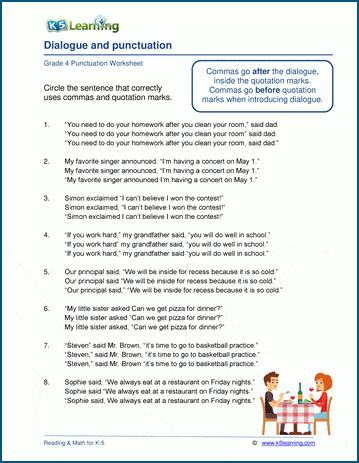These are the seven essential rules for punctuating dialogue correctly.
Use a comma to introduce dialogue
When writing dialogue, place a comma before the opening quote, unless you introduce that introduction with a conjunction such as that or whether.
For example:
My favorite singer announced, “I’m having a concert on May 1.”
Use a comma when a dialogue tag follows a quote
When a character has spoken a complete sentence, that sentence usually ends in “he said”, “she exclaimed”, “they asked”; we call these a tag. In that case that sentence does not end with a period, but with a comma.
Also, the comma rule only applies to periods. If they are questions or exclamation marks, those do follow the sentence before the tag.
For example:
“You need to finish your homework after dinner,” said dad.
“Can we get pizza for dinner?” asked my sister.
“Watch out for the car!” screamed Toby.
Periods and commas are inside the closing quotations
When closing a quotation, a period or comma always falls within the quotation.
For example:
“If you work hard,” my grandfather said,” you will do well in school.”
Question/exclamation marks and dashes can be both inside and outside closing quotations
Typically, exclamation and question marks, as well as dashes, are inside closing quotation marks.
For example:
“Watch out!” cried out Ben as he mishit the ball.
“Are you joining us for lunch?” she asked her friend.
In rare cases, the marks end up outside the quotation marks.
For example:
What book contains the phrase, “It was the best of times, it was the worst of times”?
He said, “I can’t do this” – and he walked away from him homework.
Use single quotes inside dialogue quotes
If you are quoting text inside a dialogue, use single quotes for that text.
For example:
She said, “I’ve heard people say this cell phone is ‘the phone for the next generation’, but I haven’t seen it yet.”
Don’t use capital letters after question marks, exclamation marks unless the sentence ends there
In dialogue writing, only capitalize the first letter of the first word. Don’t put capital letters for the word after an exclamation mark or question mark.
For example:
“Grandma’s here!” screamed Bella. (correct)
“Grandma’s here!” Screamed Bella. (incorrect)
Use paragraph breaks when the speaker changes
A new paragraph is created each time there’s a change in speaker.
For example:
“What would you like for dinner?” asked dad.
“I’m not sure. Can we get a takeout?” asked Raj.
“No, let’s cook something healthy,” responded dad.
Punctuation in dialogue worksheets
We’ve created a set of worksheets for students at the grade 4 level to practice punctuation in dialogue


